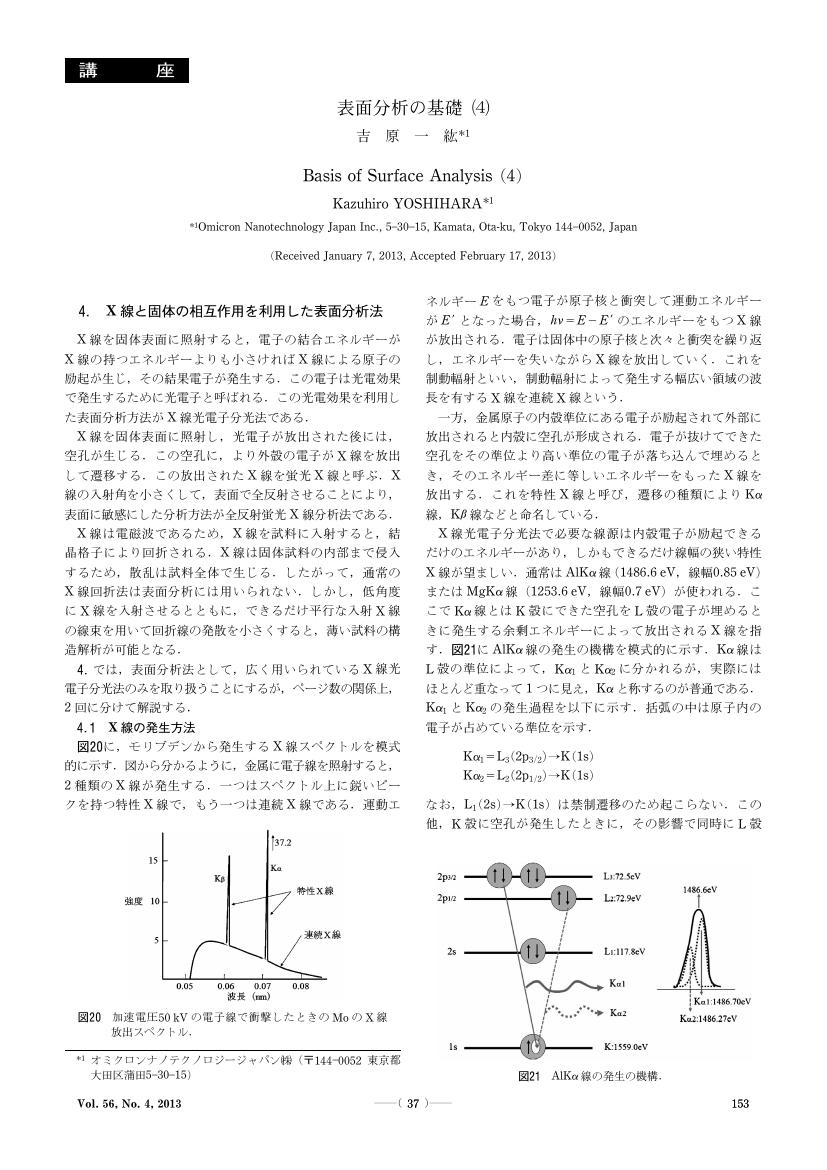1 0 0 0 OA 表面分析の基礎 (4)
- 著者
- 吉原 一紘
- 出版者
- 一般社団法人 日本真空学会
- 雑誌
- Journal of the Vacuum Society of Japan (ISSN:18822398)
- 巻号頁・発行日
- vol.56, no.4, pp.153-157, 2013 (Released:2013-05-10)
- 参考文献数
- 3
1 0 0 0 OA 動的Shirley法によるXPSスペクトルのバックグラウンド自動推定と定量分析
- 著者
- 松本 凌 西澤 侑吾 片岡 範行 田中 博美 吉川 英樹 田沼 繁夫 吉原 一紘
- 出版者
- 一般社団法人 表面分析研究会
- 雑誌
- Journal of Surface Analysis (ISSN:13411756)
- 巻号頁・発行日
- vol.22, no.3, pp.155-167, 2016 (Released:2016-05-31)
- 参考文献数
- 15
- 被引用文献数
- 9 9
XPSスペクトルのバックグラウンド推定の方法は任意性が高く,バックグラウンドの形状によってピークの強度が変わるため定量分析の結果に大きく影響する.特に,最も多用されているiterative Shirley法では,指定されたXPSスペクトルの始点と終点でのデータ点の強度に大きく依存してバックグラウンド形状が変わる.本研究では,この依存性を低減する為,バックグラウンド推定をピークフィッティング中で行う動的Shirley法に着目し,これをCOMPROに組み込んで銅酸化物超伝導体のCu 2pスペクトルやSiO2薄膜のSi 2pスペクトルに対して適用した.その結果,バックグラウンドの端点位置やピークの関数型を変化させてもバックグラウンドの形状やピーク面積について変動の少ない安定した解が得られることが明らかとなった.
1 0 0 0 OA 標準化の軌跡
- 著者
- 吉原 一紘
- 出版者
- 一般社団法人 表面分析研究会
- 雑誌
- Journal of Surface Analysis (ISSN:13411756)
- 巻号頁・発行日
- vol.22, no.1, pp.2-10, 2015 (Released:2016-04-08)
- 参考文献数
- 16
表面分析法が測定科学である以上,定量性に優れた最も良い方法は何かを探し求め,それを決定していくことが標準化のプロセスである.すなわち,標準化という作業は,表面分析を行う際に発生する誤差やばらつきを与える原因を一つ一つ科学的な検証に基づいて潰していき,最後に,それらが最も小さくなる「ワン・ベスト・ウェイ」を見つけることである.本解説では,互換性という概念から標準という概念に発展した経緯と,VAMASやISOなどの標準化活動と表面分析研究会の関わりを紹介する.
1 0 0 0 OA 金属の表面偏析及び表面析出の熱力学
- 著者
- 吉原 一紘
- 出版者
- The Surface Science Society of Japan
- 雑誌
- 表面科学 (ISSN:03885321)
- 巻号頁・発行日
- vol.6, no.5, pp.388-399, 1986-02-01 (Released:2009-11-11)
- 参考文献数
- 34
- 被引用文献数
- 2 2
In the course of heating of metals, impurities in metals often segregated to surfaces or grain-boundaries, and the compositions of surfaces or interfaces are different from that of the bulk. The properties of materials are strongly affected by these segregation behaviors.Although much research on the segregation behaviors of metals have been published already, surface thermodynamics has not been established yet. This review discusses free energy diagrams of surfaces and the segregation isotherms, largely from the point of view of Gibbs' dividing surface model and indicates how the interaction between segregants will affect the segregation behaviors on metal surfaces. Throughout this review, attempts are made to understand the basic concepts of surface thermodynamics of metals.
1 0 0 0 OA ホウ素と窒素を添加した18-8ステンレス鋼表面上への窒化ホウ素の析出挙動
- 著者
- 吉原 一紘 新居 和嘉
- 出版者
- 公益社団法人 日本金属学会
- 雑誌
- 日本金属学会誌 (ISSN:00214876)
- 巻号頁・発行日
- vol.47, no.11, pp.941-949, 1983 (Released:2008-04-04)
- 参考文献数
- 12
- 被引用文献数
- 4 2
The surface composition of 18-8 stainless steel doped with boron and nitrogen at high temperatures was observed in vacuum with AES and XPS.The precipitation of boron nitride was found on the surface of the stainless steel. At the first stage of heating, a thin layer of boron nitride flowed out from grain boundaries and spread on the surface, replacing phosphorus and sulfur which segregated all over the surface. As the heating time was prolonged, parts of the thin layer of boron nitride increased in thickness. The thickness increased in proportion to the square root of heating time and became about 0.06 μm after heated at 1100 K for 432 ks. The precipitated boron nitride was not replaced by the most surface active element, sulfur, and remained stable on the surface. On the surface of the stainless steel, however, there existed areas not covered with boron nitride after prolonged heating. On these uncovered areas, sulfur segregated.The precipitated boron nitride layer was inert to the adsorption of gases. Therefore, this stainless steel is a superior candidate material for vacuum vessels.
